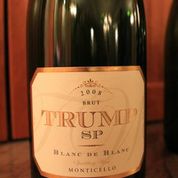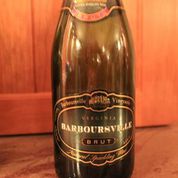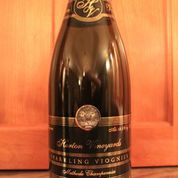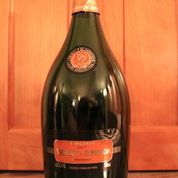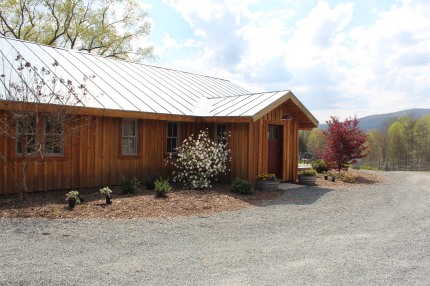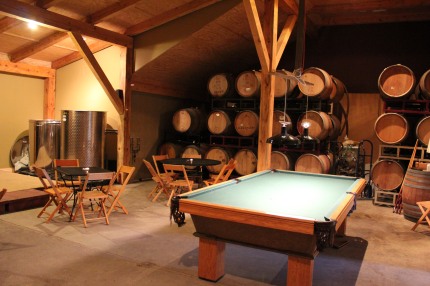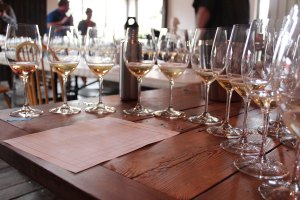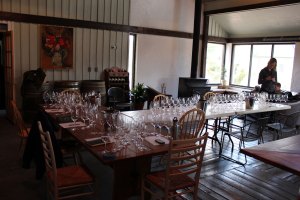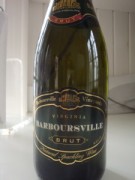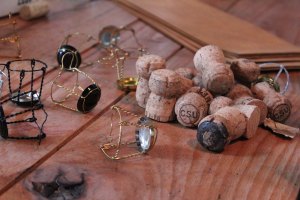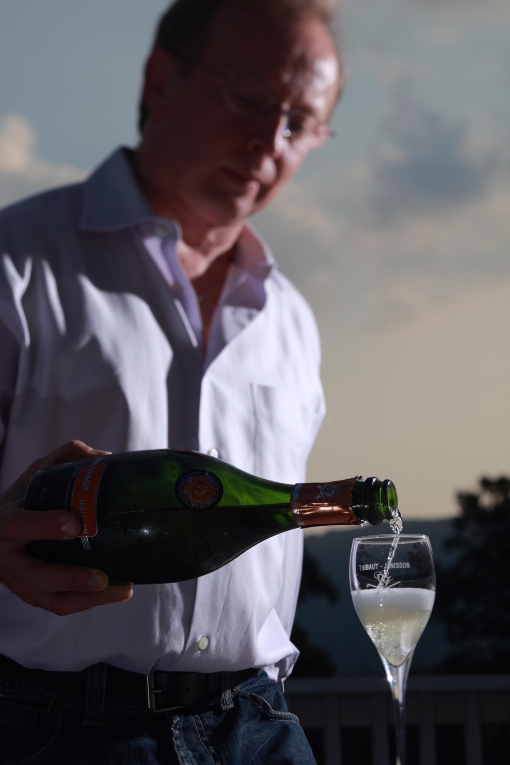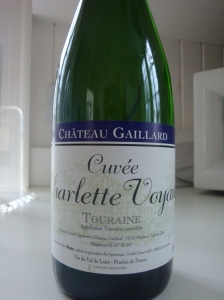Overview
We recently attended the now annual VA sparkling wine tasting organized by Frank Morgan of Drink What You Like. This year, Early Mountain Vineyards hosted us, and as always, we had a great time catching up with our blogging friends while also checking in on the state of sparkling wine in VA.
Once again, this tasting highlighted that Claude Thibaut is at the heart of quality sparkling wines in VA. Three of the top 4 wines from this tasting were made by Thibaut-Jannison Winery, and Claude Thibaut had a hand in making 3 of the other wines we tasted. Kudos to him for his top quality offerings.
Setting the Stage
This year, there were 13 wines in the line up. Ten of these were VA wines. The remaining 3 were from the Finger Lakes in NY, New Mexico, and Spain. We tasted the wines in 2 flights: one of 7 wines and one of 6 wines.
It’s always been hard to rank order across flights, but it felt particularly challenging this year, and I wasn’t the only taster who felt this way. It feels like we learn something about doing this each year, so next year, I think we’re going to limit things to 10 wines and try to taste them all in a single flight.
As a final note, once again, 2 sparkling viogniers were included. We tried this last year for the first time, and I was dubious about including them. We tried it, however. There were mixed reactions, so Frank opted to try including them again. This year, whether people liked them or not, everyone felt that they stuck out in a pool of otherwise chard-domiated wines. Given this, I think the second lesson we’re taking into next year is to stick to blanc de blancs.
With that said, on to the wines. I’ll talk about them within flights, and I’ll give you my rank for that flight, my rank across flights, and the group’s overall ranking.
Flight One
The first wine in the first flight was the ’08 Trump Winery blanc de blanc. If, like us, you’ve yet to make it to Trump, you may still be familiar with this wine from its former labeling as Kluge. I’ve been very up and down on the Kluge/Trump sparklers, and it makes me wonder if there is a lot of batch variation since I’m usually a bit more consistent. On this day, however, this wine was working for me. It was my 2nd choice in this flight, my 3rd choice overall, and clichéd the number 3 spot for the group as well. The wine offered a floral yet yeasty nose. I particularly noticed apple and peach notes as well as some flintyness.
The next glass contained the nv Thibaut-Jannison Winery Fizz. This wine felt a bit foamly to me rather than fizzy, and I wasn’t liking that aspect of it, but I did like the yeasty savoryness I found in the glass. I also noted a minerality I described as river rocks. I ranked this 3rd for this flight and 4th overall. It grabbed the 4th slot from the group as a whole as well.
Wine 3 was the nv Gruet Winery blanc de blanc which just edged out a win in last year’s tasting. This year, I found it to be overly perfumey and lacking in body. It’s still a great value, but it just wasn’t doing as much for me. I raked it 5th in this flight and 8th overall; the group ranked it 9th.
Glass 4 contained the ’08 Thibaut-Jannison Winery Cuvee D’etat. This had a very light nose, but I really enjoyed the yeasty brioche notes with apple and pear on the palate. It was a very balanced wine, and it was the wine from this flight that I most enjoyed revisiting. It ranked number 1 in this flight, 2nd overall, and 1st for the group.
The ’06 Chateau Frank blanc de noirs from Dr. Frank Vinifera Wine Cellars was up next. I had actually had this wine, and quite enjoyed it, when we were in the Finger Lakes this summer – in fact, we’ve now got a bottle on our wine rack. As the only blanc de noir in the line up, it was no surprise that the fruit flavors really came through. I notes peach, apple blossom, and a touch of light berry. There were also hints of the yeastiness I so love from sparklers. I ranked this 4th in this flight and 5th overall; the group had this one tied for 5th/6th.
The nv Jaume Serra Christalino brut cava was unquestionably my least favorite wine of this flight. My first impression was of fruit, but the flavors were muddy, and I was soon left with a chemical taste that really turned me off. Once the bottles were unblended, one taster suggested that this bottle was off given her familiarity with the wine. I’ve never had it other than as part of this tasting, so I can’t speak to that, but I’m definitely not rushing to taste it again. I ranked it 7th in this flight and 12th overall. The group ranked it 13th.
The final wine in the first flight was the nv Barboursville Vineyards brut. While this wine is fine, it’s never struck me as anything special, and this tasting didn’t change my impression. The wine felt flatter/less effervescent and it struck me as being more like a sauv blac than a chard-based sparkler. I ranked it 6th in this flight and 10th overall. It came in 7th in the group rankings.
Flight Two
Let me start by saying that this flight, overall, was a disappointment. I think a large part of the difficulty I had integrating my ratings between flights was due to my generally poor reactions to the ones in this half of the tasting.
The flight started with the’10 Afton Mountain Vineyards Bollicine. The wine was way too perfumey for my taste, and there was a note of Elmer’s Glue in there that took me right back to my childhood – fun as that can be, it’s not what I’m looking for in a sparkling wine. I raked it 5th in this flight, 11th overall, and the group ranked it 11th as well.
The nv Horton Vineyards sparkling viognier stood out as being a viongner, and not in a good way. It struck me as being light flat cream soda. This came in 6th in this flight and 13th overall. The group gave it the 12th place berth.
The other sparkling viogner, the nv Paradise Springs Winery Apres, happened to be the wine in the next glass. At first, when fairly cold, the wine struck me as yeasty and fruity. It wasn’t remarkable, but it was enjoyable – at least until a somewhat off-putting finish. As the wine warmed, however, it became too perfumey, and it just struck me as fairly flat for a sparkler. I ranked this one 4th in this flight and 9th overall. The group placed this one in the 10th spot.
Wine number four in this flight was the nv Prince Michel Winery sparkling wine. This wine struck me as bright. It was yeasty with apple and pear notes and pear-dominant finish. I ranked it 3rd in this flight and 7th overall. The group scores placed this wine in 8th.
The nv Thibaut-Jannison Winery blanc de chardonnay won my top slot in this flight and the overall tasting, although the group as a whole placed it 2nd. This wine struck me as being what I expect a sparkler to be. It had yeast on the nose and some soft fruit that came in on the palate. It was well balanced and a wine I enjoyed revisiting after the tasting had concluded.
The final was to be tasted was the nv Veritas Vineyards Scintilla. I again noticed the yeast on the nose I look for along with some floral and soft fruit notes. It was a solid wine – it just didn’t particularly stand out to me. I ranked it 2nd in this flight and 6th overall. It tied for the 5th/6th slot among the group.
Wrap Up
Claude Thibaut’s success did not surprise me. What did surprise me was how consistent I’ve been in my ratings of these wines over the last few years. The Thibaut-Jannison wines consistently rank at the top of the tasting for me, and the Barboursville and Afton wines have typically been ones I’ve struggled with. The Scintilla from Veritas has also been a fairly consistent performer over the past few years.
This type of comparative tasting is hard to do as it can get expensive, but it really is a great way to learn about a given type of wine in a region while also learning about your own preferences. If you get the chance to do one, go for it.
NOTE: All bottle pics were provided by Frank Morgan of the ever awesome Drink What You Like. I figure link love is always better than writing “credit: sexy Frank” thirteen times. -G


